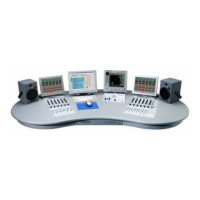OnAir 3000 Digital Mixing Console
5-88 Operation
Document generated: 10.10.14
SW V6.0
TB with User GUI Soft Buttons Additional talkback destinations may be configured to the programmable
buttons at the right-hand side of the main screen. This feature requires editing
an XML file and cannot be configured by a normal user.
5.5.3.1 Talkback Groups
Every location (TB from external, from CR, from Studio 1 - 3) has up to
four TB groups available. The operator can talk from one location to several
different TB destinations at a time by pressing a single TB group key.
Note: For dual-desk operation, both desks use the same TB groups when
using the same location (e.g. parallel operation). In case of A/B desk opera-
tion, every desk has its own TB groups.
TB Group Setup TB groups are set up as described in the steps below:
• PresstheSTORE key on the desk, or touch the STORE button on the
MON - TB SP page.
• SelecttheTBgrouptobedefined(escapebypressingSTORE again). All
currently active talkbacks from this location are turned off. All destinations
of this TB group existing already will be selected. Pressing the TB GRP x
key (or button) again will clear the selected group.
• Collectthedestinationsbyselectingthemwiththeirkeysorbuttons(or
GPI, if available). TB destinations to N–X can be selected either by press-
ing the TB key on the fader strip, or by touching the joker button configured
with the TALK function on the CHAN - FDR/Bus page.
Please note: Only destinations within the TB group’s own location may be
selected. On a split desk in a different location, N–X cannot be selected. TB
destinations of the studio microphones no. 2 to 4 can be selected only when
using GPI.
• EndbypressingSTORE again.
The TB group settings are saved in the initial and assignment snapshots.
STORE and TB GRP x key functions may be assigned to any desk key, channel-
related keys excepted.
TB Group Functions TB group activation, together with the momentary/latching key function (refer
to chapter 1.2), is very flexible and intuitive:
• Youcan,forinstance,activateordeactivateaTBgrouppermanentlyby
hitting its key (‘latching’), or just for a short while by holding its key for
as long as required (‘momentary’).
• ATBgroup’smemberthatalreadyhasbeenactivewhen the group is
activated, it remains active.
• WhileaTBgroupisactive,youcandeactivateoneorseveralofitsmem-
bers permanently by hitting the TB key of the desired group member – or
just for a short while by holding its key for as long as required.
• WhenatalkbackdestinationismemberofmorethanoneTBgroup,and
both groups have been activated at the same time, this destination is deac-
tivated as soon as one of the corresponding TB groups is deactivated.
• Youcanevende-activateagroupwithitsTBgroupkeywhilemomentarily
holding down the TB key of one of this group’s members, then this member
remains active until its TB key is released.
• WhileaTBgroupismomentarilyactivated(i.e.byholdingitsTBgroup
key), its members cannot be deactivated individually.
• AslongasaTBgroupisactive,itsownkeyisilluminated,togetherwith
the keys of all of its members.

